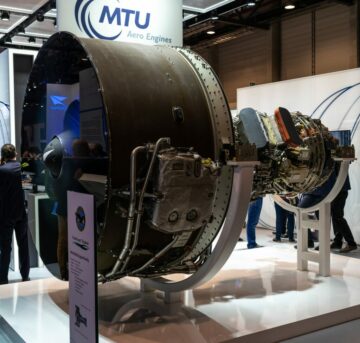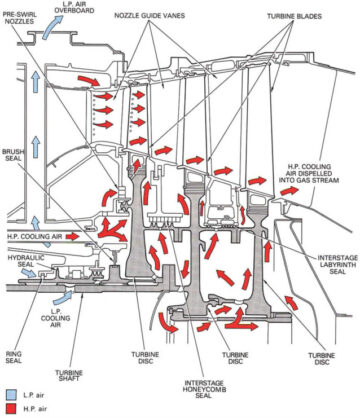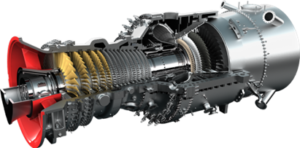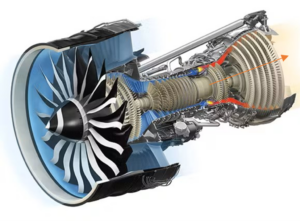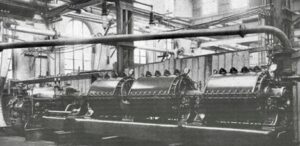A pipe diffuser is a special type of radial vane diffuser and is widely used in centrifugal compressors of gas turbine engines. Employing pipe diffusers can lead to increased efficiency in centrifugal compressors by an average of 2-4% compared to other vaned diffusers. The efficiency gains are especially prominent at high-pressure ratios (over 5.0), toward which we are seeing a growing trend in gas turbine engines.

Figure Source: Stanislaw Antas, Exhaust System for Radial and Axial-Centrifugal Compressor with Pipe Diffuser, Int J Turbo Jet Eng 2016;
Pipe Diffuser Geometry
The initial part of a pipe diffuser is a cylindrical section (throat), followed by the conical diffuser (Figure 3). The axis of the pipe diffuser must be tangent to the circle created by the tip of the centrifugal compressor, i.e., the circle defined by the impeller tip radius R2. The leading edge of the pipe diffuser channel is elliptical due to the oblique intersection of the cylindrical throat with the cylindrical surface of the diffuser radius R3. This intersection design results in gradually adapting the effluent flow from the impeller to the flow through the cylindrical and conical sections of the diffuser. The downstream duct of a compressor with a pipe diffuser is a diffusing trumpet, also called a “fishtail” diffuser.

The figures below show 2D and 3D views of a pipe diffuser in AxSTREAM.


There are several reasons to adopt pipe diffusers over alternatives in certain situations. First, they seem to have a better flow-area-to-wetted-area relationship than wedge (island) diffusers, resulting in reduced frictional losses. Second, it is often possible to obtain an improved diffusion area given the same geometrical constraints with pipe diffusers compared to wedge diffusers. Third, the elliptical leading-edge geometry can handle highly distorted flows and thus can yield lower losses at the impeller outlet. Fourth, their performance can be particularly superior at high inlet Mach numbers, which is especially important in higher-pressure-ratio stages.
Pipe diffusers carry significant efficiency benefits at supersonic inlet conditions, and do not suffer from performance deterioration at low Mach numbers compared to vaned diffusers or channel diffusers with rectangular cross sections. A comparison of the calculated performance for the compressor stage with pipe diffusers and channel wedge diffusers is presented below (Figure 7 and Figure 8). The impeller is identical in both cases (Figure 9 and Figure 10). Using the pipe diffuser increased the efficiency of the entire compressor by 2-3% on average. Also, in some cases the pipe diffuser increased the compressor’s performance itself. The comparison was made using AxSTREAM.


Summary
Pipe diffusers can be used in many areas, from industrial production to aviation. One of the main criteria for reaping their benefits is that the Mach number in absolute frame (Mc1) is greater than one at the diffuser inlet, which corresponds to pressure ratios of 4.0 and above.
Until recently, pipe diffusers were protected under patent laws. Due to data protection for commercial security purposes, the open literature and available information about them is limited. Consequently, there is currently no generally accepted approach to the design/calculation of pipe diffusers. This presents both a challenge and an opportunity for turbomachinery designers, namely, to discover the best design/calculation methods when it comes to these components.
To learn more about pipe diffusers in centrifugal compressors and the tools used in this blog, reach out to us at sales@SoftInWay.com or leave a comment below!
References:
- Kenny, D. P., Supersonic Radial Diffusers, AGARD Lecture Series 39, Advanced Compressors, 1970;
- Benett I., Tourlidakis A., Elder R.L. The design and analysis of pipe diffusers for centrifugal compressors. Proceedings of the Institution of Mechanical Engineers. Part A. Journal of Power and Energy. Vol. 214. 2000, pp. 87-96;
- Antas S., Pipe Diffuser for Radial and Axial-centrifugal Compressor. International Journal of Turbo and Jet Engines, 2014; 31(1): pp. 29-36;
- Sun Z., Zheng X., Linghu Z., Flow Characteristics of a Pipe Diffuser for Centrifugal Journal of Applied Fluid Mechanics, Vol. 10, No. 1, pp. 143-155, 2017.
- Antas S., Exhaust System for Radial and Axial-Centrifugal Compressor with Pipe Diffuser, Int J Turbo Jet Eng 2016;
- SEO Powered Content & PR Distribution. Get Amplified Today.
- Platoblockchain. Web3 Metaverse Intelligence. Knowledge Amplified. Access Here.
- Source: https://blog.softinway.com/an-introduction-to-pipe-diffusers-in-centrifugal-compressors/
- 1
- 10
- 2014
- 2016
- 2017
- 214
- 2D
- 39
- 3d
- 3D view
- 7
- 9
- a
- About
- above
- Absolute
- adopt
- advanced
- alternatives
- analysis
- and
- applied
- approach
- AREA
- areas
- Assembly
- available
- average
- aviation
- Axis
- below
- benefits
- BEST
- Better
- Blog
- calculated
- called
- carry
- cases
- certain
- challenge
- Channel
- characteristics
- Circle
- COM
- comment
- commercial
- compared
- comparison
- components
- conditions
- Consequently
- constraints
- construction
- corresponds
- created
- criteria
- Cross
- Currently
- data
- data protection
- Design
- designers
- discover
- Edge
- efficiency
- elder
- energy
- Engineers
- Engines
- Entire
- especially
- Ether (ETH)
- Figure
- Figures
- First
- flow
- Flows
- followed
- Fourth
- FRAME
- from
- Gains
- GAS
- generally
- given
- gradually
- graphs
- greater
- Growing
- handle
- High
- highly
- HTTPS
- identical
- important
- improved
- in
- increased
- industrial
- Industrial Production
- information
- initial
- Institution
- International
- intersection
- Introduction
- island
- IT
- itself
- journal
- Laws
- lead
- leading
- LEARN
- Leave
- Lecture
- Limited
- literature
- losses
- Low
- made
- Main
- many
- max-width
- mechanical
- mechanics
- methods
- more
- namely
- number
- numbers
- ONE
- open
- Opportunity
- Other
- part
- particularly
- patent
- path
- performance
- pipe
- plato
- Plato Data Intelligence
- PlatoData
- possible
- power
- presented
- presents
- pressure
- Proceedings
- Production
- prominent
- protected
- protection
- purposes
- R3
- ratio
- reach
- reasons
- recently
- Reduced
- relationship
- resulting
- Results
- same
- scheme
- Second
- Section
- sections
- security
- seeing
- Series
- several
- show
- significant
- single
- situations
- some
- special
- Stage
- stages
- superior
- supersonic
- Surface
- system
- table
- The
- their
- Third
- Through
- tip
- to
- tools
- toward
- Trend
- under
- us
- View
- views
- which
- widely
- without
- X
- Yield
- zephyrnet

